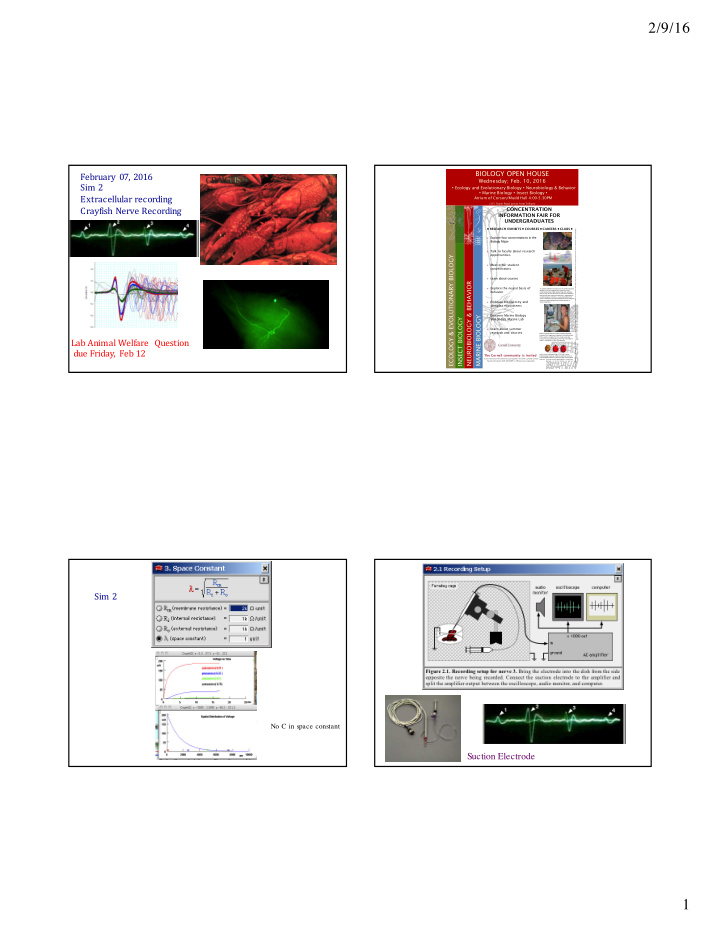



2/9/16 BIOLOGY OPEN HOUSE February ¡ 07, ¡2016 Wednesday; Feb. 10, 2016 Sim 2 • Ecology and Evolutionary Biology • Neurobiology & Behavior • Marine Biology • Insect Biology • Extracellular ¡recording Atrium of Corson/Mudd Hall 4:00-5:30PM (215 Tower Road across from Trillium) Crayfish ¡ Nerve ¡Recording CONCENTRATION INFORMATION FAIR FOR UNDERGRADUATES • RESEARCH EXHIBITS • COURSES • CAREERS • CLUBS • Background: Left: Visual cortex of human infant from Ramón y Cajal, S. (1909).. Center: The phylogene tree of vertebrates (Meyer, A. and Zardoya 2003). Right: dragonfly wings, richly diverse in morphological characters used in systematics. ipmnet.org/bugwing ! Explore four concentrations in the Biology Major ! Talk to faculty about research opportunities ECOLOGY & EVOLUTIONARY BIOLOGY ! Meet other student concentrators ! Learn about courses NEUROBIOLOGY & BEHAVIOR ! Explore the neural basis of To understand the neural basis of communication, behavior the Bass Lab investigates the neural circuits underlying vocal-motor patterning and auditory processing in fish. We also want to know whether behavioral and neural mechanisms, important for communication in fishes, are shared with other vocal vertebrates using investigatory tools ranging from neurophysiology and neuroanatomy to ! Embrace biodiversity and transcriptomics. complex ecosystems ! Discover Marine Biology MARINE BIOLOGY INSECT BIOLOGY and Shoals Marine Lab ! Learn about summer research and courses Working aboard the R/V Sharp, Marine Biology student Erin Eggleston (Hewson Lab) collects and filters water samples for her study assessing Lab ¡Animal ¡Welfare ¡ ¡Question responses of communities of marine microbes to anoxic conditions in the Chesapeake. due ¡Friday, ¡ Feb ¡12 The Cornell community is invited In the Lost Ladybug Project, Dr. John Losey, Entomology, involves citizen scientists to track If you need accommodations to participate in this event, please contact distribution patterns of these native and invasive species. The now rare 9-spot (right) is in decline. Saundra Anderson (607-254-4389 or slf42) as soon as possible. Sim 2 No C in space constant Suction Electrode 1
2/9/16 Membrane AP to amplifier output Summary Ohm’s Law How do we apply Ohm’s law? V = IR Axon AP current flows across membrane resting potential resistance, powered by resting potential Axon Extracellular V = IR AP current flowing across saline fluid Resistance generates AP voltage cha nge Extracellular fluid V oltage change causes current “flow” across metal electrodes Amplification of current flowing across amplifier input resistance Amplifier Electrode metals Bad : Al, Ch, Ti- metal oxide Amplifier layer (low Ce) Differential amplifier Ag, Cu toxic in longer term Common mode rejection Good : Gold, SS, Pt- little or for noise reduction To Oscilloscope/Computer no oxide layer Introduction to lab exercise for this week Model Systems in Neuroscience Large and identified neurons Small neural netw orks Crayfish abdominal morphology 2
2/9/16 Key references for this week’s lab: Kennedy and Takeda, 1964b Single unit analysis: reflex firing of Wine et al 1974 individual axons of different 0.4 Baseline activity Larimer and Moore 2003 diameters . 0.2 Atwood, 2008 Amplitude (mV) 0.0 Spontaneous activity of nerve 3 -0.2 -0.4 -0.6 -0.8 0 100 200 300 400 500 Time (ms) 0.4 Telson stimulated 0.2 0.0 Amplitude (mV) Stimulate tail fan -0.2 -0.4 Motor Networks in VNC -0.6 (Like spinal cord) -0.8 Alive with reflex activity 0 100 200 300 400 500 Time (ms) 0.4 Swimmeret stimulated 0.2 Amplitude (mV) 0.0 Move swimmerets -0.2 -0.4 Methylene blue stain of abdominal nervous system -0.6 -0.8 0 100 200 300 400 500 Time (ms) Example student data (last century) Example student data 3
2/9/16 Sorting ¡ spikes Goals for lab this week: How many AP classes? Any patterns of activity in total or individual AP activity? Break down firing activity of different axons Document activity in different sensory stimulation conditions. Activity change due to other reasons?? (time, temperature) Is size of AP related to conduction time? Make sure the computer is making sense. Check AP sizes on Oscilloscope too. Trigger o f f one AP and see what else shows up around it. Use the real time recording to verify different AP shapes. 4
Recommend
More recommend